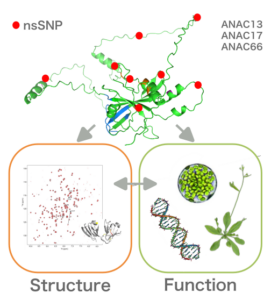
The NO APICAL MERISTEM/ATAF/CUP SHAPED COTYLEDON (NAC) family is a large plant-specific group of of transcription factors (TFs) involved in the regulation of diverse processes ranging from meristem identity, secondary wall synthesis, and senescence to numerous stress responses. Canonical NAC proteins consist of a highly conserved n-terminal NAC domain and a diverse, intrinsically disordered c-terminal region which contains only small motifs that are partially conserved within subgroups of NACs. NACs can form homo- and heterooligomers with NACs and other TFs and interact with phosphatases, kinases, E3-Ubiquitin-ligases and other proteins. While these interactions are generally mediated via the NAC domain, some interactions require the highly unstructured c-terminal domain which is primarily required for transcriptional regulation of the respective target genes. Unfortunately, structural information available so far (x-ray, NMR) is limited to the NAC domain only which allowed the identification of critical amino acid residues but so far fails to explain the highly divers function of different NAC subfamilies with respect to target gene regulation and biological contexts. We follow an interdisciplinary approach combining biophysical NMR analyses in the lab of Prof. Jochen Balbach (MLU) with our expertise in molecular biological analyses to provide a novel structure-function analysis of NAC TFs. We will exploit naturally occurring variation within the Arabidopsis gene pool by using natural proteoforms of three different Arabidopsis NAC proteins that represent two different NAC subgroups with distinct functions. We aim to: (i) identify amino acid residues within the NAC domain that affect NAC domain structure and have the capacity to modulate protein function in terms of DNA-binding and/or protein-interaction, (ii) assess the impact on naturally occurring variation within the intrinsically disordered region on the capacity for transcriptional regulation, NAC domain structure and function, and (iii) to assess the biological relevance of individual proteoform function by in vivo analyses. This project is part of the SFB1664.
